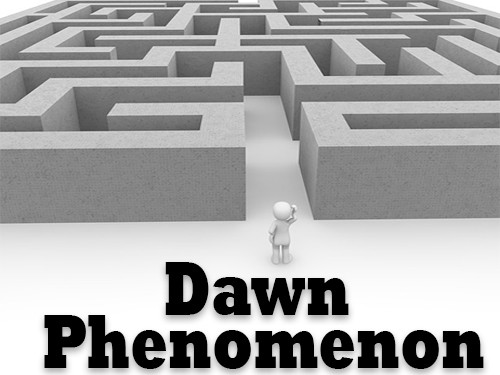
What IS the “Dawn Phenomenon” in diabetes. The Dawn Phenomenon (also known as the Dawn Effect) was defined over 30 years ago in T1D as the elevation of blood sugars during the night and early morning hours and an even greater rise in blood sugar after breakfast.
Soon after, the Dawn Phenomenon was observed in T2D as well. [1] The current definition of the Dawn Phenomenon is the need for insulin to prevent the rise of blood sugar levels in the early morning hours of predawn and dawn. So, after 30 years of research, what do we know about the Dawn Phenomenon—and what do we know about how to deal with this phenomenon?
Contents
The Biology of the Dawn Phenomenon
In normal, non-diabetic people, blood sugar and insulin secretion remain very constant overnight. Just before dawn, insulin can rise a small amount. In this sense, the Dawn Phenomenon exists in non-diabetic people as well—the phenomenon isn’t as large and because non-diabetics are not insulin resistant, their body secretes insulin and the cells respond by taking up the sugar from the blood, causing only a slight, mostly unnoticed rise in blood sugar.
However, in diabetic individuals, the Dawn Phenomenon is much more significant. Anywhere from 10-50% of people with T2D and T1D experience the dawn phenomenon.
It is believed that the rise in blood sugar during the early morning hours is due to the release of glucose from the liver—this can be referred to as a liver dump. This is due to the rise in growth hormone, cortisol, glucagon and adrenaline (epinephrine), all of which can function to stimulate the release of sugar and the synthesis of new sugar (glucose) from the liver.
Why the rise in these hormones? Because during the night, the blood sugars will drop—and when they drop below a certain level, the body reads that as a signal that it is time to release more sugar. Remember, sugars like glucose are the preferred fuel for cells and these hormones are supposed to be regulating it and keeping the cells of the body “fueled up” and ready to go, particularly in the morning.
These articles might interest you:
Symptoms of the Dawn Phenomenon
For many people, the only sign that they are experiencing the dawn phenomenon is the high blood sugar in the morning. Many people, though, experience night sweats or pounding headaches.
Steps to Deal with the Dawn Phenomenon
There are a number of possible steps to take if you are experiencing high blood sugars in the morning. The first step is to set the alarm for between 2 to 4 in the morning (sorry!). Check your blood sugar at about that time to see if your blood sugar is higher than when you went to bed.
If it is, it is likely that you are experiencing the dawn phenomenon. There are a number of approaches you can take—and you can combine them as well.[2]
- Avoid carbohydrates at and around bedtime—limit the carbohydrates to within 2 hours.
- Talk to your doctor about changing your dose of medication or your insulin dose. You can also talk to your doctor about changing the timing of your medication or insulin dose. For example, you can take your medication or insulin at bedtime rather than at dinnertime.
- Discuss switching to a different medication. For example, you may need a longer-acting insulin at night.
- Consider using an insulin pump to give yourself extra insulin during those early-morning hours.
The Liver Dump—Supporting the Liver with Alternative Approaches
You have probably heard a lot about “detoxifying the liver”. Do these methods work and why should anyone use them? Well, the liver IS the body’s major detoxifying organ and it does make good sense to take care of the liver. One of the most important functions of the liver is to take foreign substances (including medications, pollutants, various chemicals) and chemically alter them so that those substances can be excreted.
The liver does this by using an enzyme system called the P450 system as well as a number of other chemical pathways. In diabetes (and in many other conditions such as obesity, metabolic syndrome and many liver diseases), the liver can become “stuffed” with fats and sugars—the sugars are stored in the form of glycogen. During the Dawn Phenomenon, the liver is the source of most of the sugar that is released.
So, it does make sense for anyone, but particularly those with any form of diabetes, to take care of the liver. There are many unproven methods to do this—one of the most familiar to many is the olive oil, lemon juice and garlic cleanse or to buy supplements that “detox” the liver. These are methods for which there is little or no evidence. To put it bluntly, you are likely to be wasting time and money.
On the other hand, there are a number of more studied and evidence-based ways to support your liver. These include:
- Making certain you have a healthy diet, emphasizing healthy fats and complex carbohydrates. Healthy fats are the omega-3 fats found in fish, seafood, borage, some vegetables and flaxseeds. Complex carbohydrates are the unrefined whole grain-foods.
- Make certain you are getting sufficient anti-oxidant vitamins (eg. Vitamins C, E and the beta-carotenes), B-complex vitamins, and minerals such as selenium, zinc, chromium and boron. A high quality multi-vitamin with minerals along with a varied, healthy diet should provide those.
- Investigate the use of herbs traditionally used to support the liver. There is a reasonably significant amount of research supporting the use of milk thistle[3], dandelion root (which may also help control blood sugar)[4], turmeric and Jerusalem artichoke, but there is also a lot of “hype” out there, so find a naturopath or a medical herbalist who will work with you and your doctor to find what might be beneficial for you. Also, you should always keep in mind that the liver ALSO can chemically alter herbs—and often, this activity in the liver is what causes drug interactions with herbs. So, always talk to your physician and pharmacist about any and all medications and herbs you are taking to make sure they don’t interact with one another, making your diabetes medication more or less effective.
For more additional information I suggest these articles:
What is the Somogyi effect? Is that the same thing as the Dawn Phenomenon?
- The Somogyi effect is related to the Dawn Phenomenon but is a bit different—the Somogyi effect is a “rebound hyperglycemia” – when blood sugars bounce too high in response to low blood sugar in the evening. It does not happen overnight (as in the dawn phenomenon) and it usually happens when medication or insulin is too high.
Is the Dawn Phenomenon a serious problem for diabetic patients?
- Yes, the Dawn Phenomenon can be a serious problem for diabetic patients, depending on the severity of the high blood sugars in the morning. The spikes of high blood sugars are thought to be the most damaging because the see-saw effect of high and then low blood sugars can be damaging to cells and increase their insulin resistance. In addition, many of the complications of diabetes such as peripheral neuropathy and the retinopathies (problems with the eye’s retina and with vision) are due at least in part to the spikes of high blood sugar.
I have high morning blood sugar—do I have dawn phenomenon?
- It is a possibility depending on the status of your medications, insulin and how much carbohydrates were in your last meal the day before. Try taking your blood sugar between 2-4 in the morning and try some of the approaches listed above. Make sure you talk to your doctor before changing any medications.
Hopefully this explained the dawn phenomenon and diabetes correlation.
If you have any experiences with high blood sugar in the morning post your experiences down below.
TheDiabetesCouncil Article | Reviewed by Dr. Sergii Vasyliuk MD on June 10, 2020
References
- http://care.diabetesjournals.org/content/36/12/3860
- http://www.mayoclinic.org/diseases-conditions/diabetes/expert-answers/dawn-effect/faq-20057937
- https://www.ncbi.nlm.nih.gov/pmc/articles/PMC4310066/
- https://www.ncbi.nlm.nih.gov/pubmed/28012278
- https://www.ncbi.nlm.nih.gov/pmc/articles/PMC5553762/
- https://www.ncbi.nlm.nih.gov/pubmed/24968200
- https://www.ncbi.nlm.nih.gov/pubmed/7667959




